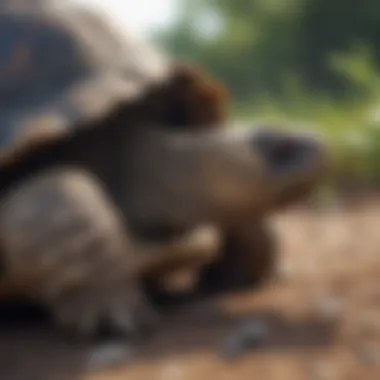Complete Guide to Caring for Your Tortoise


Intro
Caring for tortoises is multifaceted, demanding a detailed look at their habitat, diet, and health. This guide dives into each requirement, offering insights necessary for thriving tortoise care. Understanding the nuances is essential, whether you're a novice welcoming a tortoise home for the first time or an experienced owner looking to refine your knowledge.
Habitat Setup
Creating an appropriate habitat for a tortoise is crucial. In nature, these reptiles roam large areas, so even in captivity, they need space to explore. The habitat terrarium should be big enough to allow movement and mimic natural terrain. Substrates such as organic soil mixed with sand can anchor their natural instincts and facilitate burrowing. Create a warm area for basking, ideally with a heat lamp, while providing cooler spots. Consider also the humidity levels depending on the species.
Essential Equipment
- Basking Light: Needed for heat and UVB rays.
- Thermometers: To monitor the temperature precisely.
- Humidity Gauge: Essential for proper humidity levels.
Dietary Requirements
Tortoise nutrition varies depending on species. Most tortoises are herbivores, requiring a diet rich in leafy greens, grasses, and vegetables. Offering a wide variety prevents deficiencies. Some species can tolerate more fruit than others; check specific dietary needs of your species.
Foods to Include
- Kentucky Blue Grass: Good for fiber intake.
- Dandelion Greens: Great source of calcium.
- Squash and cucumbers: These provide hydration, especially in warm months.
Avoid overfeeding high-calcium foods like kale or spinach can bring issues, as balance is the aim in tortoise parenting.
Health Monitoring
Regular health checks are pivotal in ensuring a tortoise lives a long and healthy life. Keep a record of their eating habits, restroom activity, and mobility. Any unusual signs may indicate stress or health issues.
Signs of a Healthy Tortoise
- Shell Condition: Should be smooth without any visible cracks.
- Eyes: Bright and clear without any discharge.
Noticing sudden behavior changes or loss of appetite is often the first red flag indicating further investigation or veterinarian assistance might be necessary.
Behavioral Insights
Understanding the natural behaviors of tortoises functions as a guide to their care. Tortoises are generally solitary, but some enjoy gentle interaction. Frequent, quiet time closer to their environment can help in bond building. Additionally, they engage in basking and burrowing behaviors that should not discouraged in captivity. By observing these activities, any shifts in patterns may signal discomfort or health concerns.
Common Behaviors
- Basking: Essential for thermoregulation.
- Eating: Should happen consistently, keeping an eye on their dietary patterns is smart.
Ending
In summary, tortoise care enriches both the owner and the pet's lives. Attention to their habitat, diet, health, and behavior ensures that these dictated animals thrive. This guide provides the clarity needed for anyone who embraces the responsibility of keeping a tortoise. By distilling knowledge into key points, we make it easier for tortoise lovers to maintain the quality of life that leads to well-lived, vibrant years ahead.
Understanding Tortoises
Understanding tortoises is essential for their care and sustainable ownership. These reptiles have distinct needs, life spans, and natural behaviors that must be understood for them to thrive in a captive environment. Learning about their specific requirements can profoundly impact their health and happiness. It allows owners to make informed decisions about habitat, diet, and general care, leading to a fruitful and long-lasting relationship.
The Different Species of Tortoises
Tortoises belong to the family Testudinidae, which encompasses many species differing in size, habitat, and care requirements. Here are a few common species:
- Sulcata Tortoise: Known for its large size and thick shell. It requires ample space to roam and a warm climate.
- Russian Tortoise: Smaller in size, this species is popular among pet owners for its manageable size and gentle demeanor.
- Leopard Tortoise: Characterized by its unique patterned shell, it requires specific nourishment and environmental conditions.
- California Desert Tortoise: A protected species that needs an arid environment, focusing on vegetation for sustenance.


Understanding these species helps tailor the care approach needed.
Lifespan and Lifetime Commitment
Tortoises typically have a long lifespan, often exceeding fifty years, with some species even surpassing one hundred. This long longevity necessitates a significant lifetime commitment from any potential owner. Planned care has multiple implications:
- Long-Term Care: Owners need to prepare for the future, accounting for changes in living situations or personal capacities over time.
- Dependence: Unlike many pets, tortoises do not simply look for food and shelter; they require attention to their diet, grooming, and habitat management.
- Investment: Besides time, consider financial costs of food, maintaining the habitat, and potential veterinary care.
In summary, careful consideration of their species and lifespan is important before owning a tortoise. They are not a temporary commitment but a long-term partnership requiring ample attention and resources.
Creating the Ideal Habitat
Creating a proper habitat for tortoises is a fundamental aspect of their care. This stage is not merely about aesthetics or personal preference; it is essential for the tortoises' well-being and longevity. Various species have specific habitat requirements that must be satisfied to replicate their natural environments as closely as possible. A well-designed habitat leads to healthier animals that exhibit natural behaviors. The critical component of a successful housing setup includes enclosure size, substrate suitability, temperature and humidity maintenance, and adequate lighting. Each section explores what each element entails and why they play crucial roles in proper tortoise care.
Enclosure Size Requirements
The size of the enclosure considerably affects a tortoise's lifestyle. Inadequate space can cause stress and impede their movement, potentially impacting their health over time. Different species require differing sizes; for example, a sulcata tortoise needs ample space to move due to its size potential. A rectangular shape is generally preferable because it provides more usable space. As a guideline, at least 10 square feet of space per inch of the tortoise's shell length should be allocated. However, follow these important rules:
- Always provide additional room for your tortoise to roam as it grows.
- Avoid placing the enclosure in high-traffic areas, as this can lead to anxiety.
Designing an exterior area, such as a yard or garden, may also be beneficial if local weather conditions permit it. Safe outdoor enclosures can allow tortoises to engage in natural habits under supervision.
Substrate and Ground Cover
Selecting the best substrate is essential for the physical and mental health of tortoises. They naturally interact with ground materials such as soil, sand, and grasses. As such, type of substrate can affect their behavior and comfort significantly. Here is what to consider when choosing:
- Natural Materials: Soil mixed with sand can aid in digging and help maintain moisture levels without becoming waterlogged.
- Avoidance of Chemical Substrates: Avoid wood shavings or any products that might contain harmful additives or chemicals.
- Daily Maintenance: Required for substrate cleanliness to reduce the risk of infections or other health issues. The substrate should be topped up periodically, ensuring that the environment remains comfortable.
Different tortoise species might prefer different ground coverings, so research specific needs to ensure optimal conditions.
Temperature and Humidity Control
Temperature regulation should be carefully managed because tortoises rely on external heat sources. Reptiles have cold-blooded biology, meaning they cannot internally regulate temperature. Because of this:
- Basking Areas: Include heated areas in their habitat for basking. This should be between 85 to 100 degrees Fahrenheit, as different species vary slightly.
- Cool Areas: Provide cooler spots in the enclosure, at about 70 to 75 degrees Fahrenheit, which will allow them to thermoregulate more effectively.
Controlling humidity levels is essential too. A dry environment can lead to health conditions, such as respiratory problems or shell deformities. Maintain suitable humidity levels of 40–60 percent depending on the species. Utilizing misting systems or humidity gauges can optimize the microclimate.
UVB Lighting and Its Importance
Ultraviolet B (UVB) lighting is critical for tortoises, especially if they reside indoors. It is crucial for natural behaviors and essential activities like thriving and basking. Sunlight is where they obtain vital nutrients, such as vitamin D3, thus lighting arrangements in habitat setups should mimic this exposure. Here is what to understand:
- Use Quality Bulbs: Invest in quality UVB bulbs. These should be specifically designed for reptile use and replaced every six months as their efficiency diminishes with extended use.
- Placement: Position lights above basking spots within the habitat for maximum absorbance. On a practical note, ensuring that the light source doesn’t achieve direct contact with your pet is important to avoid burns.
Following these elements is paramount as they contribute significantly to a tortoise’s health and behavior. Creating an optimal environment will not just make a comfortable home; it enhances their longevity and quality of life.
Nutrition Essentials
Proper nutrition is vitally important for the overall health and well-being of tortoises. Like all reptiles, tortoises have evolved specific dietary needs that must be met for them to thrive. A well-balanced diet ensures normal growth, healthy shell development, and optimal functioning of bodily systems. Poor nutrition can lead directly to health issues, hinder a tortoise's growth, or reduce its lifespan.
Understanding Tortoise Diets
Understanding tortoise diets begins with recognizing their natural feeding habits. Most tortoises are herbivores, which means their diet should primarily consist of plant materials. They typically consume a variety of grasses, leaves, and herbs. Some species may occasionally eat fruits, but these should only be offered as treats due to high sugar content. The exact dietary needs may vary significantly between species. Desert tortoises, for instance, thrive on drought-resistant vegetation, whereas tropical tortoises may require more moisture-rich vegetation. It is important for tortoise owners to research and understand the specific dietary requirements of their species.
Key Nutritional Requirements


Nutritional requirements for tortoises focus on several critical components:
- Fiber: Essential for digestion, an adequate amount of fiber comes mainly from leafy greens and grass hay. Fiber helps prevent gastrointestinal issues, which are common in tortoises that consume low-fiber diets.
- Protein: Young tortoises require more protein for growth than adults. The source of protein should be varied and may include commercial pelleted food for tortoises or shelled nuts.
- Calcium: To prevent shell deformities, tortoises need a regular intake of calcium. Many owners use dietary supplements that can be sprinkled on food for that extra boost.
- Water: While tortoises do not drink large quantities of water, they require hydration. A shallow dish of water should always be available for your tortoise to soak and drink.
Feeding a varied diet not only fulfills their nutritional needs but also enhances their quality of life.
By maintaining a diverse diet enriched with key nutrients, tortoise owners can significantly improve their pet's health outcomes.
Common Foods and Toxic Plants
When preparing foods for a tortoise, selection should consist of a mixture of safe greens and flowers. Some common safe foods include:
- Dandelion greens
- Clover
- Collard greens
- Kale
- Endive
However, equally important is knowing which plants to avoid. Common toxic plants include:
- Azalea
- Oleander
- Foxglove
- Tomato leaves
Always ensure foods are pesticide-free and cleaned properly. Observing these maternal aspects can lay the foundation for a long and healthy life for any tortoise.
In sum, understanding tortoise diets, key nutritional requirements, and identifying both common and toxic foods is crucial for their well-being. When owners successfully address these dietary elements, they contribute significantly to a tortoise's health, leading to a rewarding companionship.
Health Monitoring
Monitoring the health of your tortoise is crucial for its well-being. Just like any other pet, tortoises have specific health needs that must be consistently addressed. Regular health checks not only help you catch potential issues early but also ensure your tortoise leads a healthy and fulfilling life. Keeping a close eye on their behavior, physical condition, and dietary habits enables tortoise owners to intervene effectively when necessary. Engaging in regular observation can also enhance your bond with your pet, leading to better behavior and more responsive care.
Signs of a Healthy Tortoise
Identifying signs of a healthy tortoise is your first measure towards effective monitoring. Understanding how a well tortoise looks and behaves will provide essential cues if something is amiss. Key indicators of a healthy tortoise include:
- Clear and bright eyes
- A smooth, hard shell with no cracks
- Smooth skin with no lesions or flakiness
- Healthy appetite; should show interest in food
- Active, lively behavior, showing resistance to lethargy
- Normal bowel movements, not overly liquid or persistent shedding
Regularly checking these signs can help you detect health issues early. Always be attentive to unusual behavior, such as hiding or a decrease in eating and drinking. These could be hints of underlying health problems.
Common Health Issues
Tortoises, like all pets, can encounter various health issues. Familiarizing yourself with these potential concerns is vital in maintaining your tortoise’s health. Common health issues include:
- Respiratory issues: Symptoms include wheezing or difficulty breathing. Poor housing can be a cause.
- Shell problems: Softening, cracking, or discoloration are signs that should not be ignored.
- Parasites: Some tortoises suffer from internal or external parasites, indicated by weight loss or lethargy.
- Metabolic bone disease: A consequence of inadequate calcium and UV exposure, resulting in soft and deforming shells.
Being aware of these issues allows every tortoise owner to create a preventive care plan. Create a habitat that minimizes risks by controlling environment factors.
When to Consult a Veterinarian
Determining the right time to visit a veterinarian can significantly affect the health outcomes for a tortoise. While regular monitoring is essential, it is equally important to know when professional advice is vital. Consult a veterinarian if:
- Your tortoise refuses to eat and drink for more than a few days, a clear indication it’s developed refusal behavior.
- You notice any discharge from the eyes or nostrils, excluding normal shedding.
- There are visible changes in shell condition, like heed slessness.
- The tortoise is inactive compared to its regular behavior, suggesting stress.
- Any signs of pain or discomfort, such as unusual tortoise postures or swelling.
Taking proactive steps ensures that any health issues do not become serious. Regular veterinary check-ups not only promote physical well-being but also instruct you on your tortoise’s individual needs.
Remember, prevention is better than treatment. Regular health checks and being inquisitive about changes in your tortoise’s behavior can build a healthier and longer life for them.
Behavioral Insights
Understanding tortoise behavior is crucial for any owner aiming to create a suitable and nurturing environment for these animals. A significant part of tortoise care revolves around recognizing and interpreting their habits and interactions. Grasping the essentials can prevent stress and promote overall well-being.


Understanding Tortoise Behavior
Tortoises exhibit unique behavioral patterns that are vital for their survival in the wild. These behaviors include activities such as navigating their habitat, foraging for food, and controlling body temperature using sunlight or shade.
Tortoises are mostly crepuscular, becoming active during cooler parts of the day at dawn and dusk. Monitoring these activity patterns allows owners to create suitable daily routines. Observing a tortoise diligently digging, exploring, or basking should not just be seen as idle activity. These behaviors indicate a well-adjusted tortoise engaging in instinctual actions.
- Recognizing individual quirks is also helpful. Some tortoises may be more curious or social than others.
- A cat or dog may seek attention actively, but tortoises may appear aloof; their subtler forms of social behavior can be equally important.
Social Interactions and Enrichment
Tortoises, unlike many social animals, do not naturally rely on interaction for comfort. However, enrichment plays a significant role in their behavior. A more engaging habitat stimulates intellectual activity and reduces boredom.
Decorating their enclosure using various elements promotes exploration. Including items like:
- Natural hiding spots such as rocks and logs
- Different types of vegetation for foraging climbs
- Shallow water areas for drinking or soaking
As social interactions go, introducing tortoises should be done judiciously. They can be territorial. Introducing them slowly can lessen aggression and to enhance potential bonding.
Recognizing Stress and Anxiety
Observing signs of stress is an important aspect of tortoise care. Stress can impair health dramatically and must be addressed immediately. Some indicators of a stressed tortoise might include:
- Hiding excessively
- Altered eating patterns
- Biting or retracting into their shells
In contrast, a healthy tortoise will generally exhibit a relaxed posture and an eagerness to explore its environment.
As owners, knowledge of natural behavior can help you create a stress-free habitat. Maintaining appropriate environmental conditions is key. Factors such as secure enclosures that allow for comfortable movement and natural temperature ranges are significant. By observing these behavioral insights, owners ensure the longevity and happiness of their tortoises.
Legal Considerations
Understanding the legal landscape surrounding tortoise ownership is fundamental for anyone considering these reptiles as pets. Legal considerations may not be as visible as health or dietary needs, yet they play a crucial role in ensuring that owners properly respect wildlife standards and contribute to the conservation of different tortoise species. By familiarizing oneself with relevant laws and regulations, owners can make informed decisions that protect both the tortoise and the owner from legal repercussions.
Understanding Wildlife Protection Laws
Wildlife protection laws are enacted to preserve and protect various species from unlawful capture and trade. These laws often stem from ethical concerns as well as biological interests to maintain biodiversity. For tortoises, many species fall under protective legislation due to their declining populations.
In many countries, it is important to be aware of the International Union for Conservation of Nature (IUCN) red list. This document categorizes species based on their risk of extinction. Failing to comply with these regulations can lead to legal issues. Key points to consider regarding these laws include:
- Different tortoise species may have varying protective statuses.
- It's generally illegal to remove tortoises from the wild.
- Breeders might need to prove that their stock comes from legal sources to avoid fines.
- Understanding local state or provincial laws is crucial since regulations often vary by region.
Growing awareness about conservation is beneficial for consumers, as more reputable breeders often become more credible and less likely to use unsustainable practices. Owners should perform due diligence before acquiring a tortoise..
Keep in mind that engaging in illegal practices endangers tortoise populations and can incur hefty fines or even imprisonment for violators.
Permits and Regulations for Ownership
Acquiring a tortoise may require various permits depending on your location. These regulations are put in place to curb illegal possession and ensure ethical care and breeding practices. When discussing permits related to tortoise ownership, several factors come into play.
- State Regulations: Some states require permits for owning specific turtle and tortoise species. Always check your local wildlife authority for current regulations.
- CITES Regulations: Many tortoise species are listed under the Convention on International Trade in Endangered Species of Wild Fauna and Flora (CITES). This necessitates import and export permits when dealing with such species across borders.
- Health Certifications: In various locations, a health certificate may be necessary before legally acquiring a tortoise. This is to ensure the animal is free from disease, which protects both moral and legal aspects of ownership.
As you consider bringing a tortoise into your home, understand the relevant permits are vital. Navigating these legal waters may seem daunting, but it is a critical step for responsible animal ownership. In following legal guidelines and best practices, you not only assure the welfare of your tortoise but are also doing your part to protect their populations in the wild.
Epilogue
In this article, we explored the complexity of tortoise care, covering crucial elements such as habitat setup, nutritional needs, and health monitoring. Each aspect of tortoise maintenance is imperative not just for survival, but also for a flourishing life. Understanding these requirements positions an owner to provide a safe and enjoyable environment for their tortoise.
Being compliant with legal regulations furthers the goal of promoting tortoise welfare. Many species face threats in their native habitats due to human activities. This makes it essential to be knowledgeable about local laws and regulations. Ownership should always align with animal welfare standards and conservation efforts.
Furthermore, an appreciation for the unique needs of individual tortoise species deepens the bond between owner and pet. These reptiles boast varied diets, behavioral traits, and health requirements, all of which merit careful consideration.
In summary, the sensitivity of tortoises to environmental change and diet reinforces the responsibility of owners to stay informed. Review the habits, signs of health, and stress indicators regularly. With consistent effort, owners can ensure their tortoises thrive into old age. Knowledge is not simply a privilege but rather a necessity in fostering healthy relationships with these animals. The lifespan of some tortoise species often stretches beyond 50 years. This indicates a long-term commitment and heightens the importance of adopting best practices for care. By synthesizing all the information, we hope to inspire tortoise owners to create better living conditions and enhance their understanding of these remarkable creatures.















